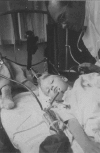Intensive care medicine is 60 years old: the history and future of the intensive care unit
- PMID: 25099838
- PMCID: PMC4952830
- DOI: 10.7861/clinmedicine.14-4-376
Intensive care medicine is 60 years old: the history and future of the intensive care unit
Abstract
Intensive care is celebrating its 60th anniversary this year. The concept arose from the devastating Copenhagen polio epidemic of 1952, which resulted in hundreds of victims experiencing respiratory and bulbar failure. Over 300 patients required artificial ventilation for several weeks. This was provided by 1,000 medical and dental students who were employed to hand ventilate the lungs of these patients via tracheostomies. By 1953, Bjorn Ibsen, the anaesthetist who had suggested that positive pressure ventilation should be the treatment of choice during the epidemic, had set up the first intensive care unit (ICU) in Europe, gathering together physicians and physiologists to manage sick patients - many would consider him to be the 'father' of intensive care. Here, we discuss the events surrounding the 1952 polio epidemic, the subsequent development of ICUs throughout the UK, the changes that have occurred in intensive care over the past 10 years and what the future holds for the specialty.
Keywords: Intensive care; polio; tracheostomy; ventilation.
© 2014 Royal College of Physicians.
Figures
Comment in
-
The history and future of intensive care units.Clin Med (Lond). 2014 Dec;14(6):694. doi: 10.7861/clinmedicine.14-6-694. Clin Med (Lond). 2014. PMID: 25468870 Free PMC article. No abstract available.
References
-
- Reynolds LA, Tansey EM, eds. History of British intensive care, c.1950–c.2000. Wellcome Witnesses to Twentieth Century Medicine, vol. 42 London: Queen Mary, University of London, 2011.
Publication types
MeSH terms
LinkOut - more resources
Full Text Sources
Other Literature Sources
Medical
Miscellaneous




